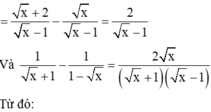Cho biểu thức A = x + 4 x + 4 x + x - 2 + x + x 1 - x : 1 x + 1 - 1 1 - x (với x > 0; x ≠ 1)
A. A = x x + 1
B. A = x - 1 x
C. A = x + 1 x
D. A = 1 x + 1
Hãy nhập câu hỏi của bạn vào đây, nếu là tài khoản VIP, bạn sẽ được ưu tiên trả lời.








Bạn nên gõ đề bằng công thức toán (biểu tượng $\sum$ góc trái khung soạn thảo) để mọi người hiểu đề và hỗ trợ bạn tốt hơn nhé.

a: Khi x=25 thì \(A=\dfrac{5+1}{5-2}=\dfrac{6}{3}=2\)
b: \(B=\dfrac{\sqrt{x}}{\sqrt{x}+1}+\dfrac{1-\sqrt{x}}{\sqrt{x}-2}-\dfrac{\sqrt{x}+4}{x-\sqrt{x}-2}\)
\(=\dfrac{\sqrt{x}}{\sqrt{x}+1}+\dfrac{1-\sqrt{x}}{\sqrt{x}-2}-\dfrac{\sqrt{x}+4}{\left(\sqrt{x}-2\right)\left(\sqrt{x}+1\right)}\)
\(=\dfrac{\sqrt{x}\left(\sqrt{x}-2\right)+\left(1-\sqrt{x}\right)\left(1+\sqrt{x}\right)-\sqrt{x}-4}{\left(\sqrt{x}-2\right)\left(\sqrt{x}+1\right)}\)
\(=\dfrac{x-2\sqrt{x}+1-x-\sqrt{x}-4}{\left(\sqrt{x}-2\right)\left(\sqrt{x}+1\right)}\)
\(=\dfrac{-3\sqrt{x}-3}{\left(\sqrt{x}-2\right)\left(\sqrt{x}+1\right)}=-\dfrac{3}{\sqrt{x}-2}\)
c: P=B:A
\(=\dfrac{-3}{\sqrt{x}-2}:\dfrac{\sqrt{x}+1}{\sqrt{x}-2}=-\dfrac{3}{\sqrt{x}+1}\)
P<-1
=>P+1<0
=>\(\dfrac{-3+\sqrt{x}+1}{\sqrt{x}+1}< 0\)
=>\(\sqrt{x}-2< 0\)
=>\(\sqrt{x}< 2\)
=>0<=x<4
mà x nguyên
nên \(x\in\left\{0;1;2;3\right\}\)

Lời giải:
ĐKXĐ: $x\geq 0; x\neq 1; x\neq 25$
a)
\(A=\frac{4\sqrt{x}}{\sqrt{x}-5}:\left[\frac{(\sqrt{x}-2)(\sqrt{x}+2)+\sqrt{x}-1}{(\sqrt{x}-1)(\sqrt{x}+2}+\frac{5-2\sqrt{x}}{(\sqrt{x}-1)(\sqrt{x}+2)}\right]\)
\(=\frac{4\sqrt{x}}{\sqrt{x}-5}:\frac{x-4+\sqrt{x}-1+5-2\sqrt{x}}{(\sqrt{x}-1)(\sqrt{x}+2)}\)
\(=\frac{4\sqrt{x}}{\sqrt{x}-5}:\frac{\sqrt{x}(\sqrt{x}-1)}{(\sqrt{x}-1)(\sqrt{x}+2)}=\frac{4\sqrt{x}}{\sqrt{x}-5}:\frac{\sqrt{x}}{\sqrt{x}+2}=\frac{4\sqrt{x}}{\sqrt{x}-5}.\frac{\sqrt{x}+2}{\sqrt{x}}=\frac{4(\sqrt{x}+2)}{\sqrt{x}-5}\)
b) Tại $x=81$ thì $\sqrt{x}=9$.
Khi đó: $A=\frac{4(9+2)}{9-5}=11$
c) $A< 4\Leftrightarrow \frac{\sqrt{x}+2}{\sqrt{x}-5}< 1$
$\Leftrightarrow \frac{7}{\sqrt{x}-5}< 0\Leftrightarrow \sqrt{x}-5< 0$
$\Leftrightarrow 0\leq x< 25$. Kết hợp với ĐKXĐ suy ra: $0\leq x< 25; x\neq 1$

`a)|x-2|=2<=>[(x=4(ko t//m)),(x=0(t//m)):}`
Thay `x=0` vào `A` có: `A=[2\sqrt{0}-3]/[\sqrt{0}-2]=3/2`
`b)` Với `x >= 0,x ne 4` có:
`B=[2(\sqrt{x}-3)+\sqrt{x}(\sqrt{x}+3)-4\sqrt{x}]/[(\sqrt{x}+3)(\sqrt{x}-3)]`
`B=[2\sqrt{x}-6+x+3\sqrt{x}-4\sqrt{x}]/[(\sqrt{x}+3)(\sqrt{x}-3)]`
`B=[x+\sqrt{x}-6]/[(\sqrt{x}+3)(\sqrt{x}-3)]`
`B=[(\sqrt{x}+3)(\sqrt{x}-2)]/[(\sqrt{x}+3)(\sqrt{x}-3)]`
`B=[\sqrt{x}-2]/[\sqrt{x}-3]`
`c)` Với `x >= 0,x ne 4` có:
`C=A.B=[2\sqrt{x}-3]/[\sqrt{x}-2].[\sqrt{x}-2]/[\sqrt{x}-3]=[2\sqrt{x}-3]/[\sqrt{x}-3]`
Có: `C >= 1`
`<=>[2\sqrt{x}-3]/[\sqrt{x}-3] >= 1`
`<=>[2\sqrt{x}-3-\sqrt{x}+3]/[\sqrt{x}-3] >= 0`
`<=>[\sqrt{x}]/[\sqrt{x}-3] >= 0`
Vì `x >= 0=>\sqrt{x} >= 0`
`=>\sqrt{x}-3 > 0`
`<=>x > 9` (t/m đk)

Bài 1:
a: \(A=\dfrac{x^2-3+x+3}{\left(x-3\right)\left(x+3\right)}\cdot\dfrac{x+3}{x}=\dfrac{x\left(x+1\right)}{x\left(x-3\right)}=\dfrac{x+1}{x-3}\)
b: Để A=3 thì 3x-9=x+1
=>2x=10
hay x=5
Bài 2:
a: \(A=\dfrac{x+x-2-2x-4}{\left(x-2\right)\left(x+2\right)}:\dfrac{x+2-x}{x+2}\)
\(=\dfrac{-6}{x-2}\cdot\dfrac{1}{2}=\dfrac{-3}{x-2}\)
b: Để A nguyên thì \(x-2\in\left\{1;-1;3;-3\right\}\)
hay \(x\in\left\{3;1;5;-1\right\}\)

1,
\(A=\dfrac{4x^2}{\left(x-2\right)\left(x+2\right)}+\dfrac{x-2}{\left(x-2\right)\left(x+2\right)}-\dfrac{x+2}{\left(x-2\right)\left(x+2\right)}\)
\(=\dfrac{4x^2+x-2-\left(x+2\right)}{\left(x-2\right)\left(x+2\right)}=\dfrac{4x^2-4}{\left(x-2\right)\left(x+2\right)}\)
\(x=4\Rightarrow A=\dfrac{4.x^2-4}{\left(4-2\right)\left(4+2\right)}=...\)
2.
\(A=\dfrac{x\left(x+1\right)}{\left(x-1\right)\left(x+1\right)}+\dfrac{3\left(x-1\right)}{\left(x-1\right)\left(x+1\right)}+\dfrac{3-5x}{\left(x-1\right)\left(x+1\right)}\)
\(=\dfrac{x\left(x+1\right)+3\left(x-1\right)+3-5x}{\left(x-1\right)\left(x+1\right)}=\dfrac{x^2-2x+1}{\left(x-1\right)\left(x+1\right)}\)
\(=\dfrac{\left(x-1\right)^2}{\left(x-1\right)\left(x+1\right)}=\dfrac{x-1}{x+1}\)
3.
Đề lỗi, thiếu dấu trước \(\dfrac{6+5x}{4-x^2}\)
4.
\(A=\dfrac{2x}{\left(x-5\right)\left(x+5\right)}-\dfrac{5\left(x+5\right)}{\left(x-5\right)\left(x+5\right)}-\dfrac{x-5}{\left(x-5\right)\left(x+5\right)}\)
\(=\dfrac{2x-5\left(x+5\right)-\left(x-5\right)}{\left(x-5\right)\left(x+5\right)}=\dfrac{-4x-20}{\left(x-5\right)\left(x+5\right)}\)
\(=\dfrac{-4\left(x+5\right)}{\left(x-5\right)\left(x+5\right)}=\dfrac{-4}{x-5}\)
\(x=\dfrac{4}{5}\Rightarrow A=\dfrac{-4}{\dfrac{4}{5}-5}=\dfrac{20}{21}\)
5.
\(M=\dfrac{x^2}{x\left(x+2\right)}+\dfrac{2x}{x\left(x+2\right)}+\dfrac{2\left(x+2\right)}{x\left(x+2\right)}\)
\(=\dfrac{x^2+2x+2\left(x+2\right)}{x\left(x+2\right)}=\dfrac{x^2+4x+4}{x\left(x+2\right)}\)
\(=\dfrac{\left(x+2\right)^2}{x\left(x+2\right)}=\dfrac{x+2}{x}\)
\(x=-\dfrac{3}{2}\Rightarrow M=\dfrac{-\dfrac{3}{2}+2}{-\dfrac{3}{2}}=-\dfrac{1}{3}\)

a: |x-1|=3
=>x-1=3 hoặc x-1=-3
=>x=-2(nhận) hoặc x=4(loại)
Khi x=-2 thì \(A=\dfrac{4+4}{-2-4}=\dfrac{8}{-6}=\dfrac{-4}{3}\)
b: ĐKXĐ: x<>4; x<>-4
\(B=\dfrac{-\left(x+4\right)}{x-4}+\dfrac{x-4}{x+4}-\dfrac{4x^2}{\left(x-4\right)\left(x+4\right)}\)
\(=\dfrac{-x^2-8x-16+x^2-8x+16-4x^2}{\left(x-4\right)\left(x+4\right)}=\dfrac{-4x^2-16x}{\left(x-4\right)\left(x+4\right)}\)
=-4x/x-4
c: A+B
=-4x/x-4+x^2+4/x-4
=(x-2)^2/(x-4)
A+B>0
=>x-4>0
=>x>4

\(a.A=\dfrac{x^2}{x^2-4}-\dfrac{x}{x-2}+\dfrac{2}{x+2}\\ \Rightarrow A=\dfrac{x^2-x\left(x+2\right)+2\left(x-2\right)}{\left(x-2\right)\left(x+2\right)}\\ \Rightarrow A=\dfrac{x^2-x^2-2x+2x-4}{\left(x-2\right)\left(x+2\right)}\\ \Rightarrow A=\dfrac{-4}{\left(x-2\right)\left(x+2\right)}\)
b, thay x=1\(\Rightarrow A=\dfrac{-4}{\left(1-2\right)\left(1+2\right)}=\dfrac{-4}{-1.3}=\dfrac{-4}{-3}=\dfrac{4}{3}\)

giải phương trình
a)\(\sqrt{x^8}=256\) b)\(\sqrt{x^2-2x+1}=x-1\)